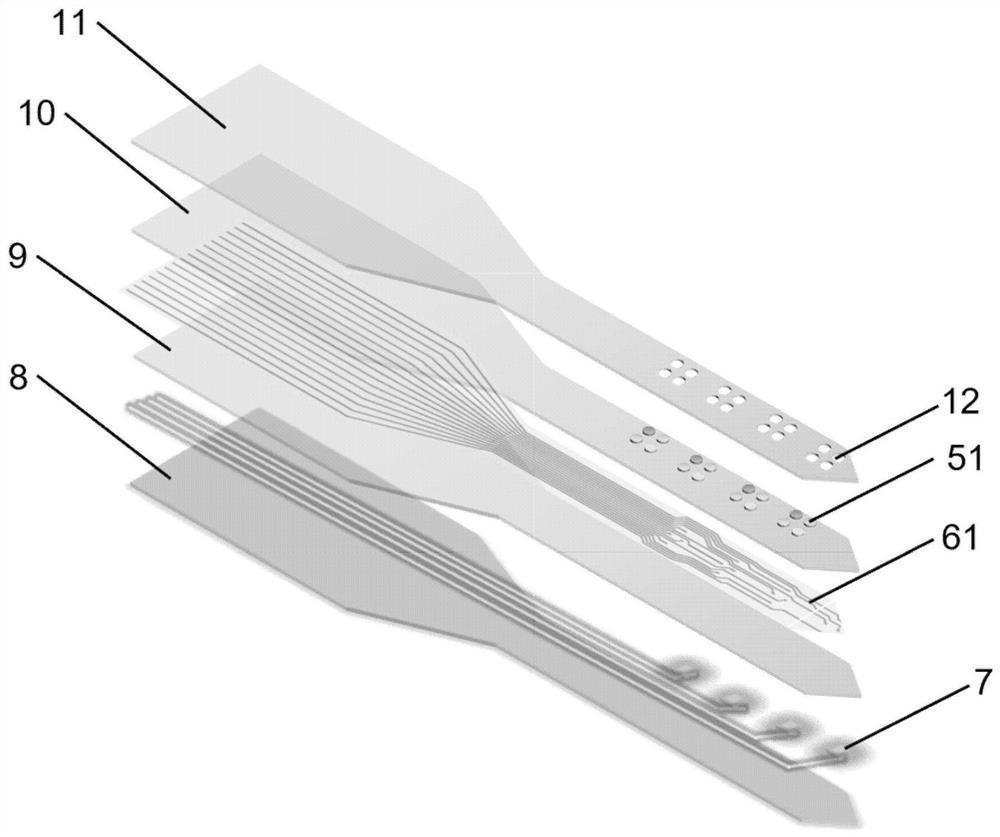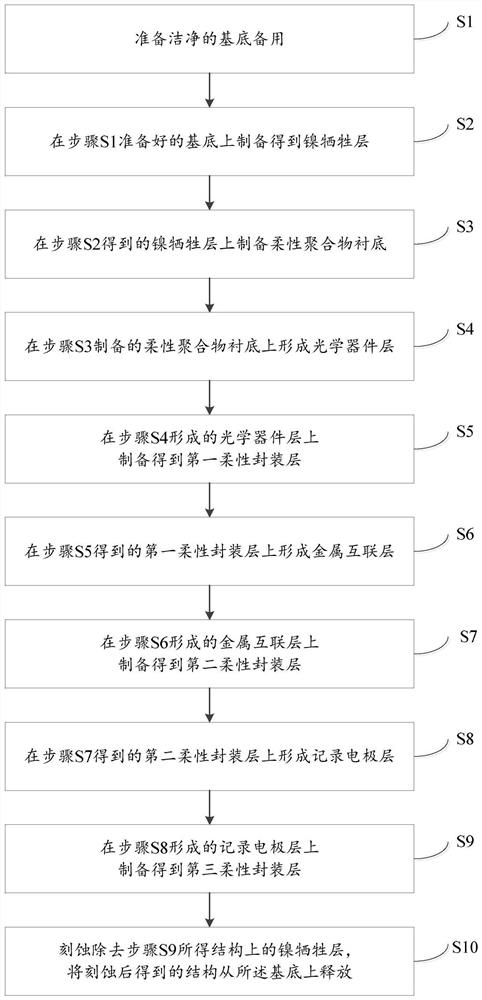Flexible implantable neural photoelectrode and preparation method thereof
An implantable photoelectrode technology, applied in the field of neuroscience, can solve the problems of limited device integration, difficulty in long-term in vivo recording, and great difference in Young's modulus, and achieve long-term in vivo stable recording and high-density signal recording , reduce the effect of nerve scarring
- Summary
- Abstract
- Description
- Claims
- Application Information
AI Technical Summary
Problems solved by technology
Method used
Image
Examples
Embodiment 1
[0063] This embodiment provides a flexible implantable neural photoelectrode, and the flexible implantable neural photoelectrode 1 is arranged at the front end of a neuroimaging system with photoelectric stimulation and recording functions. The structure of the neuroimaging system is as follows figure 1 shown. The front end of the neuroimaging system is the flexible implantable neurophotoelectrode 1 , and the electrical and optical access points of the flexible implantable neurophotoelectrode 1 are drawn out through a small PCB circuit board 2 . The small PCB circuit board 2 is connected with the back-end EEG dedicated processing chip 4 of the neuroimaging system through a flexible cable 3 . Wherein, the flexible cable 3 includes an optical fiber and a cable. The back-end dedicated EEG processing chip 4 is used to collect the EEG signals obtained by the front-end of the neuroimaging system and further analyze and process the obtained EEG signals.
[0064] The structure of t...
Embodiment 2
[0067] This embodiment provides a method for preparing the above-mentioned flexible implantable neural photoelectrode 1, see image 3 as well as figure 2 and Figure 4 , the method includes the following steps:
[0068] S1: Prepare a clean substrate 13 for use.
[0069] Preferably, the substrate 13 is a single-polished silicon wafer with a thickness of 300-500 μm (for example, 400 μm), and the single-polished silicon wafer is cleaned and ready for use.
[0070] S2: Prepare a nickel sacrificial layer 14 on the substrate 13 prepared in step S1.
[0071] Specifically, photoresist (such as SU-8 photoresist) is patterned by photolithography on the single-polished silicon wafer prepared in step S1, and a layer thickness is prepared on the photoresist by thermal evaporation deposition process. The metal nickel is 50-150 nm (for example, 100 nm), and the metal nickel is subjected to a lift-off process to obtain the nickel sacrificial layer 14 .
[0072] S3: Prepare a flexible po...
Embodiment 3
[0091]This embodiment provides a method for implanting the above-mentioned flexible implantable neural photoelectrode 1 into the mouse brain for optogenetics research. The specific implantation method of the flexible implantable neural photoelectrode 1 is as follows:
[0092] 1) First, weld the structure obtained in the second embodiment through step S9 to the PCB circuit board 2 at the rear end of the neuroimaging system, and then align the optical fiber 15 to the input grating 721 at a certain angle through the bracket 16 and fix it on the PCB circuit board 2 Above, the incident light will be emitted from the optical fiber 15 and coupled into the tapered waveguide 711 through the input grating 721. The tapered waveguide 711 converts the optical transmission mode from multi-mode to single-mode, and enters the subsequent single-mode waveguide 71 for transmission, such as Figure 5 shown;
[0093] 2) Etching and removing the nickel sacrificial layer on the structure obtained i...
PUM
 Login to View More
Login to View More Abstract
Description
Claims
Application Information
 Login to View More
Login to View More - R&D
- Intellectual Property
- Life Sciences
- Materials
- Tech Scout
- Unparalleled Data Quality
- Higher Quality Content
- 60% Fewer Hallucinations
Browse by: Latest US Patents, China's latest patents, Technical Efficacy Thesaurus, Application Domain, Technology Topic, Popular Technical Reports.
© 2025 PatSnap. All rights reserved.Legal|Privacy policy|Modern Slavery Act Transparency Statement|Sitemap|About US| Contact US: help@patsnap.com



